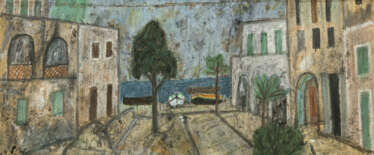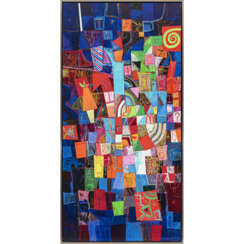
Paintings Classic Modern — 409-4 | Moderne und Contemporary Kunst

Alfons Walde was an Austrian expressionist painter and architect.
He studied architecture at the Higher Technical School in Vienna, but became interested in painting, found his muse in his native Kitzbühel Alps and became famous for his paintings of their snow-covered slopes and mountain huts. He was particularly fascinated by the dashing skiers of the time. Walde's popularity grew along with the popularity of the ski resort. Walde was also an active graphic artist and designed many posters.

Václav Spála is a Czech artist, graphic artist, designer and illustrator, one of the most important figures in Czech contemporary art.
He studied at the Prague Academy, was a member of the group Tvrdošížní ("Stubborn") and was a member of the Manes association. He was also a member of the Group of Fine Artists in Prague, a group of young Czech Cubist modernists.
He is again and again inspired by the summer landscape, partly Czech, partly Mediterranean, flowers in a vase or still life with fruit. To this day, Vaclav Spala's work still attracts with its linear and colorful rhythms, lightness of form, expressive handwriting and clear and playful intonation. By combining two opposing worlds - the world of French modernism and the world of the Czech countryside, cubism and folk art - unique works were created, not only for the Czech Republic. Spala also worked on stage designs, posters, book covers and created a series of toys.

Horst Antes was a German painter, graphic artist and sculptor, a pioneer of the new figurative painting in Germany.
After studying at the Karlsruhe Academy of Fine Arts from 1957 to 1959, Antes taught there himself and later became a professor there.
Antes became known for the Kopffüßler (head-foot) image, which has been a recurring theme in his paintings, sculptures and graphic works since the early 1960s. Antes' work is represented in several major collections in Berlin, Hamburg, Cologne and elsewhere in Germany.

Max Peiffer Watenphul was a German artist. Described as a "lyric poet of painting", he belongs to a "tradition of German painters for whom the Italian landscape represented Arcadia." In addition to Mediterranean scenes, he regularly depicted Salzburg and painted many still lifes of flowers. As well as oil paintings, his extensive body of work encompasses watercolours, drawings, enamel, textiles, graphic art, and photographs.

Max Peiffer Watenphul was a German artist. Described as a "lyric poet of painting", he belongs to a "tradition of German painters for whom the Italian landscape represented Arcadia." In addition to Mediterranean scenes, he regularly depicted Salzburg and painted many still lifes of flowers. As well as oil paintings, his extensive body of work encompasses watercolours, drawings, enamel, textiles, graphic art, and photographs.

Max Peiffer Watenphul was a German artist. Described as a "lyric poet of painting", he belongs to a "tradition of German painters for whom the Italian landscape represented Arcadia." In addition to Mediterranean scenes, he regularly depicted Salzburg and painted many still lifes of flowers. As well as oil paintings, his extensive body of work encompasses watercolours, drawings, enamel, textiles, graphic art, and photographs.

Max Peiffer Watenphul was a German artist. Described as a "lyric poet of painting", he belongs to a "tradition of German painters for whom the Italian landscape represented Arcadia." In addition to Mediterranean scenes, he regularly depicted Salzburg and painted many still lifes of flowers. As well as oil paintings, his extensive body of work encompasses watercolours, drawings, enamel, textiles, graphic art, and photographs.

Ludwig Bock was a German painter and graphic artist, draughtsman, and illustrator.
He studied painting at the Munich Academy and was a member of the Munich Secession. Bock's work was influenced by Matisse and Cézanne, as well as by the artists of the Scholl circle. His watercolors, painted mainly in Paris and inspired by the Impressionists who lived there, depict landscapes, folk and fair scenes, and nude scenes.

Ludwig Bock was a German painter and graphic artist, draughtsman, and illustrator.
He studied painting at the Munich Academy and was a member of the Munich Secession. Bock's work was influenced by Matisse and Cézanne, as well as by the artists of the Scholl circle. His watercolors, painted mainly in Paris and inspired by the Impressionists who lived there, depict landscapes, folk and fair scenes, and nude scenes.

Mac Zimmermann is a German painter, graphic artist and illustrator, one of the most important representatives of Surrealism in Germany.
He completed his studies at the Werkkunstschule for Applied Arts in his native Szczecin, then worked in Hamburg as a draftsman, stage designer and teacher at a private drawing school. In 1939 Mac Zimmermann moved to Berlin, where his first exhibition of fantasy paintings and drawings was held in 1940. In his works Zimmermann created a kind of mythology of our time, a mythology of nature and historical events.

Emil Scheibe was a German painter and graphic artist and member of the Munich Secession.
He studied at the Academy of Fine Arts in Munich, served in the army during World War II and painted portraits, including of soldiers and commanders. Emil Scheibe's giant 1942 oil painting Hitler at the Front, which depicts soldiers surrounding the leader on the front lines, is well known. Adolf Hitler liked this epic painting so much that he bought it himself, and it is now housed in a museum at a military base in Virginia, USA. From 1941 to 1944, Scheibe was featured in every major German art exhibition at the House of German Art in Munich. His watercolors were purchased by Hitler's generals, including Joseph Goebbels. Visual propaganda played a central role in Hitler's ascent.
During his long life, Scheibe painted in a wide variety of genres and styles, but it is believed that he developed his own style of "existential realism."

Valentin Assenov is a Bulgarian painter who lives and works in the picturesque city of Pleven.
He studied painting at the Cyril and Methodius University of Veliko Tarnovo. Assenov's canvases are skillful examples of the combination of vivid color and abstract composition inspired by the traditional Bulgarian landscape. His expressive style of painting shows great boldness in the use of color as well as a distinctive style and skill, and his still lifes are literally bursting with color and good humor. Assenov's paintings are part of the collection of the Bulgarian Ministry of Culture and are also widely represented in private collections in Bulgaria, Germany and Turkey.

Valentin Assenov is a Bulgarian painter who lives and works in the picturesque city of Pleven.
He studied painting at the Cyril and Methodius University of Veliko Tarnovo. Assenov's canvases are skillful examples of the combination of vivid color and abstract composition inspired by the traditional Bulgarian landscape. His expressive style of painting shows great boldness in the use of color as well as a distinctive style and skill, and his still lifes are literally bursting with color and good humor. Assenov's paintings are part of the collection of the Bulgarian Ministry of Culture and are also widely represented in private collections in Bulgaria, Germany and Turkey.

Iliya Zhelev is a Bulgarian painter who lives and works in his hometown of Plovdiv.
He graduated from St. Cyril and Methodius University in Veliko Tarnovo in painting and is one of the leading contemporary artists not only in Bulgaria, but also in Europe.
Zhelev's works are abstract paintings, portraits and depictions of cities, characterized by his distinct and recognizable style. He is inspired as much by Bulgarian folklore and carpet weaving as by contemporary European art, as by the renowned masters Klee, Kandinsky and Polyakov. Zhelev uses the complex classical technique of glaze painting, in which layer upon layer is applied, alternating with long drying phases. As a result, his works acquire the typical brightness that makes up his unmistakable handwriting.

Iliya Zhelev is a Bulgarian painter who lives and works in his hometown of Plovdiv.
He graduated from St. Cyril and Methodius University in Veliko Tarnovo in painting and is one of the leading contemporary artists not only in Bulgaria, but also in Europe.
Zhelev's works are abstract paintings, portraits and depictions of cities, characterized by his distinct and recognizable style. He is inspired as much by Bulgarian folklore and carpet weaving as by contemporary European art, as by the renowned masters Klee, Kandinsky and Polyakov. Zhelev uses the complex classical technique of glaze painting, in which layer upon layer is applied, alternating with long drying phases. As a result, his works acquire the typical brightness that makes up his unmistakable handwriting.

Tom Hartwig is an Austrian artist and restorer.
He trained as an art restorer in Salzburg, where he also met famous artists. Since 1974 he has worked in Germany, including as an art restorer, but he has become increasingly fascinated by painting.
Tom Hartwig's world is colorful and strange; he creates powerful, large-format works, which he often frames as diptychs or triptychs. He is fascinated by the processes of nature and its power, especially "creative destruction. A volcanic eruption preparing the earth for a new life, a planetary explosion resulting in the formation of thousands of stars are the main subjects of the artist.





































